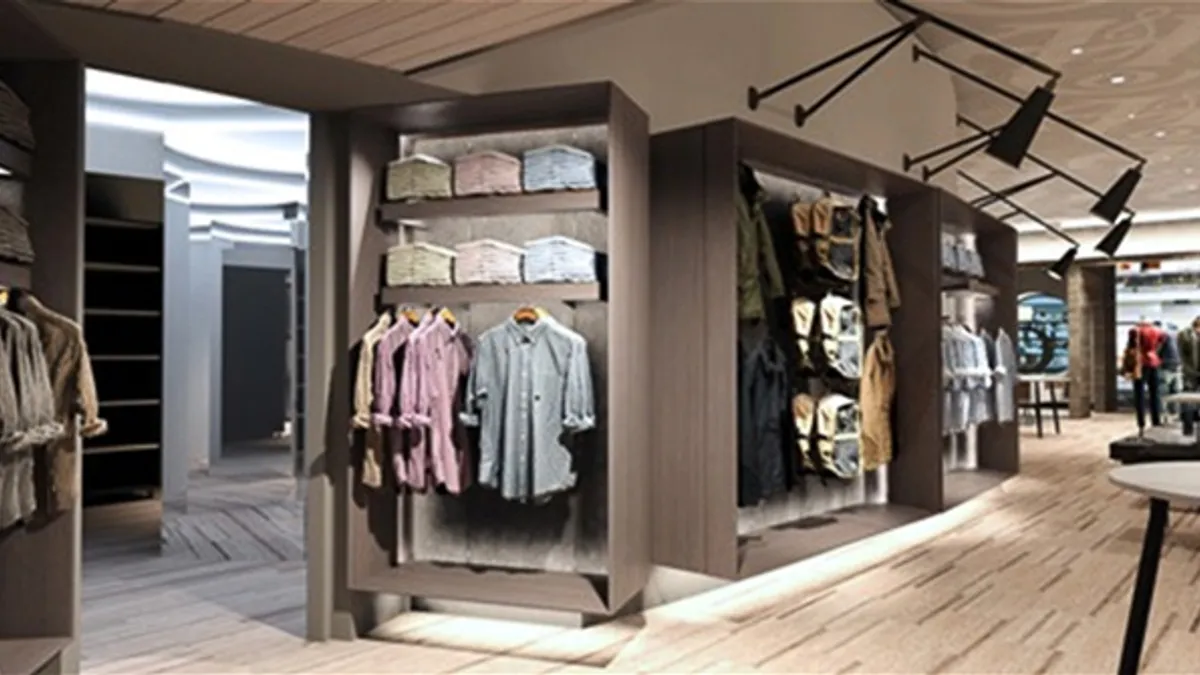Dive Brief:
-
Abercrombie & Fitch Co. opened its new A&F store concept at Tysons Corner Center in Virginia on August 5. Tysons Corner has more than 2 million square feet of fashion, dining and entertainment and is home to more than 300 specialty stores and restaurants, as well as attracting more than 25 million visitors annually, according to a press release.
-
The new concept, as unveiled in February in hometown Columbus, Ohio, includes a shop-in-shop featuring a fragrance "apothecary" and another spotlighting seasonal capsule collections. Mannequins for both genders "live" on a concrete platform in the front half of the store. Larger, capsule-like fitting rooms enable shoppers to share looks with a friend or family member while maintaining privacy; associates help guests place and pick up online orders in store, and cash wraps installed throughout the space facilitate more efficient checkout experiences.
-
Last week the retailer said it’s also updating select stores with a refreshed design, including one at Houston’s Memorial City Mall. That updated store incorporates elements of the prototype, including the refurbished logo from 1892, the open concept layout, and the runway for customers to have better visibility to the product, according to a company press release.
Dive Insight:
Abercrombie's new store approach signals its latest attempt to make good on repeated promises to turn up the lights in the darkly-lit, heavily perfumed stores — an approach held over from the tenure of CEO Mike Jeffries, who created an exclusive ethos catering to some mythic cool kid.
At this point, Jeffries been gone going on three years, but the retailer has been slow to find a replacement identity. The new prototype hews more closely to Abercrombie's roots as an all-American brand that "reflects that confidence and independence of spirit as well as our own dedication to a more diverse and inclusive culture," the company said last October, with an emphasis on more diverse and clothed models, more denim and less logo-centric clothing. (From pictures and the company’s description of its new store, the interpretation of what that means sounds upscale and masculine.)
The rebrand seeks to take advantage of Abercrombie’s 125-year history as a preppy American retailer, newly-minted CEO Fran Horowitz has said. But while A&F's Hollister brand has a California surf vibe gaining some traction, the flagship’s changes so far haven’t resonated with the fickle teen demographic. Some observers are questioning the pivot to appeal to an older consumer, presumably one with more money to spend, which this store redesign seems to also foster. Eric Beder of Wunderlich Securities wrote in a note last fall that marketing to an older age group "makes little sense ... Frankly, there are better brands and lifestyles for the 20 plus customer to focus on."
Abercrombie's reputation has also suffered from diversity issues, with a bruising loss in 2015 at the U.S. Supreme Court, which ruled in an 8-1 decision that a job applicant who wore a hijab for religious reasons and was denied a job could indeed sue for discrimination. A lawsuit filed last year over a transgender employee’s firing shows that the company’s "look policy" may still be getting it in trouble.
Those ongoing legal issues may have helped place Abercrombie among the least-liked brands in America, according to the American Customer Satisfaction Index. With apparel purchases already slipping, Abercrombie can’t afford a damaged reputation. That has led to efforts like an anti-bullying campaign and a push to talk about environmental sustainability. Moreover, the newly announced store concepts came weeks after Abercrombie laid off 150 of its 2,200 workers at its New Albany, Ohio headquarters, further suggesting that time may be running out as the initial promise of Abercrombie's re-branding efforts has disappeared and its turnaround is now "firmly off track," according to Neil Saunders, managing director of GlobalData Retail.
"A&F has much more work to do in building a new base of customers and we maintain that this is a long term effort that may not have a tangible impact on sales for many quarters," Saunders said in a note emailed to Retail Dive last month. "We also believe that a focus on more staple products with less emphasis on branding — even though correct in terms of what the customer is demanding — could necessitate lower price points, which could ultimately erode margin and profit."
In May, the struggling apparel retailer had said it was "in preliminary discussions with several parties regarding a potential transaction," reportedly including rivals American Eagle Outfitters and Express. In February, the company promoted Horowitz to CEO — as president and chief merchandising officer, she led the turnaround of the teen apparel retailer’s better-performing Hollister brand. Abercrombie & Fitch, however, recently terminated discussions about selling itself.















